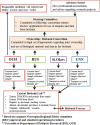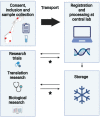The Norwegian childhood cancer biobank
- PMID: 34541832
- PMCID: PMC9351664
- DOI: 10.1002/cnr2.1555
The Norwegian childhood cancer biobank
Abstract
Background: The rapidly expanding era of "omics" research is highly dependent on the availability of quality-proven biological material, especially for rare conditions such as pediatric malignancies. Professional biobanks provide such material, focusing on standardized collection and handling procedures, distinctive quality measurements, traceability of storage conditions, and accessibility. For pediatric malignancies, traditional tumor biobanking is challenging due to the rareness and limited amount of tissue and blood samples. The higher molecular heterogeneity, lower mutation rates, and unique genomic landscapes, however, renders biobanking of this tissue even more crucial.
Aim: The aim of this study was to test and establish methods for a prospective and centralized biobank for infants, children, and adolescents up to 18 years of age diagnosed with cancer in Norway.
Methods: Obtain judicial and ethical approvals and administration through a consortium, steering committee, and advisory board. Develop pipelines including SOPs for all aspects in the biobank process, including collection, processing and storing of samples and data, as well of quality controlling, safeguarding, distributing, and transport.
Results: The childhood cancer biobanking started at Oslo University Hospital in March 2017 and was from 2019 run as a national Norwegian Childhood Cancer Biobank. Informed consent and biological samples are collected regionally and stored centrally. Approximately 12 000 samples from 510 patients and have been included by January 1, 2021, representing a 96% consent and participation rate among our newly diagnosed patients.
Conclusion: A well-functioning nationwide collection and centralized biobank with standardized procedures and national storage for pediatric malignancies has been established with a high acceptance among families.
Keywords: biobank; cancer; pediatric tumors; prospective; tissue collection.
© 2021 The Authors. Cancer Reports published by Wiley Periodicals LLC.
Conflict of interest statement
The authors have stated explicitly that there are no conflicts of interest in connection with this article.
Figures



References
-
- Shaw DM, Elger BS, Colledge F. What is a biobank? Diff Def Among Biobank Stakehold. 2014;85(3):223‐227. - PubMed
Publication types
MeSH terms
LinkOut - more resources
Full Text Sources
Medical

